Craving Cantonese desserts like sweet red bean soup 紅豆沙 (hung4 dau2 saa1)? Today, we will talk about crave-worthy and delicious desserts!
Whether it’s sweet, tasty, cold, or hot, you can find it in Cantonese desserts! Aside from the breathtaking views in Hong Kong, there are a whole lot of other things that you’ll surely love, like the Cantonese desserts.
There are wide varieties of traditional Cantonese desserts in Hong Kong, ranging from pastries, soups, puddings, salads, iced desserts, and more. By just walking along the streets of Hong Kong, you’ll see a lot of eateries and dessert restaurants that serve different Cantonese desserts. But if you can’t be in Hong Kong right now, let us walk you through some famous Cantonese desserts that you must taste.
Delicious Cantonese Desserts
The Cantonese word for dessert is 甜品 (tim4 ban2). An authentic Cantonese-style dining experience wouldn’t be complete without ending it with a delicious dessert. So, here are some classic Hong Kong desserts that you must try!
雙皮奶 (Soeng1 Pei4 Naai5) – Milk pudding

Let’s start with a Cantonese dessert that has a lot huge fan base – the milk pudding (soeng1 pei4 naai5). Hong Kong residents love milk puddings, which are regarded in Cantonese cuisine for their soft, silky texture. These bowls of egg-white-set custard are available plain or with a subtle ginger syrup flavoring.
芝麻卷 (Zi1 Maa4 Gyun2)- Black Sesame Rolls

Black sesame rolls are a traditional Cantonese treat prepared with sesame, water chestnut flour, corn starch, vegetable oil, and wheat flour. The mixture is stretched onto a thin sheet, refrigerated, then rolled into chewy rolls.
蛋撻 (Daan2 Daat3) – Egg Tarts

It’s undeniable that a box of these marigold-colored tarts is a must-taste when you’re in Hong Kong. There are different variants of egg tarts which may be the one with puff pastry, shortcrust pastry, or the Portuguese versions that are common in Macau.
楊枝甘露 (Joeng4 Zi1 Gam1 Lou6)- Mango Pudding With Sago And Pomelo

The next Cantonese dessert that we will talk about is Mango Pudding With Sago And Pomelo, also known as Mango Pomelo Sago. This is usually the go-to dessert for children, made with fresh mango, fresh pomelo, and chewy sago. If you wanna level it up, you can put evaporated milk drizzled on top of creamy pudding that had set in a cup or glass.
紅豆沙 (Hung4 Dau2 Saa1)- Sweet Red Bean Soup
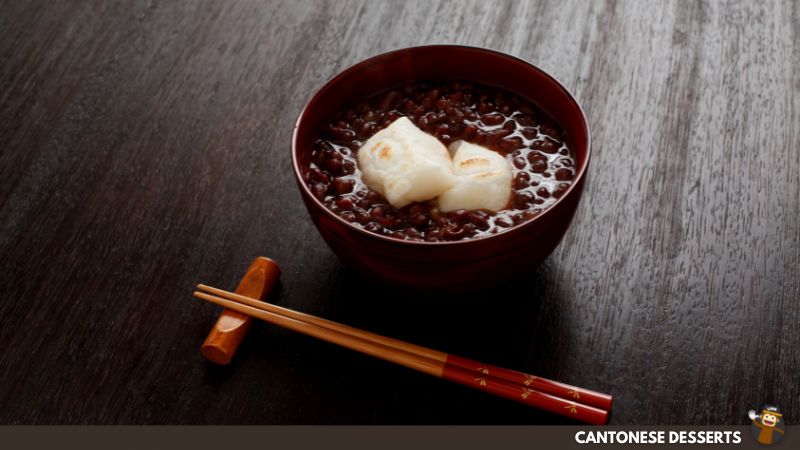
Sometimes, don’t like to eat dessert for health reasons. But, if you want a healthy choice of dessert, red bean soup is a good option. One of the healthiest dessert choices is red bean soup (紅豆沙 hung4 dau2 saa1) which is made of adzuki beans.
This hearty dessert has a lot of protein and fiber and is also said to help reduce bloating after a big meal. Its name came from the fact that it has a bit sandy texture. Just a suggestion, at the dessert place, you can ask for more or less red beans in your soup, depending on how chewy you want.
綠豆沙 (Luk6 Dau6 Saa1) – Green Bean Soup

The next one is also a soup, but this time, it’s a green bean soup 綠豆沙 (luk6 dau6 saa1). It’s like the red bean soup, but instead of using adzuki beans, it uses mung beans. According to traditional Chinese food therapy, this dessert is “cooling,” making it the perfect summer dessert or snack. “Green bean sand” also purges toxins and lowers blood pressure.
芝麻糊 (zi1 maa4 wu2)- Black Sesame Soup

Have you tried eating a charcoal-colored soup? It might be unimaginable, but there is a Cantonese dessert soup that is black in color, and it’s called the black sesame soup. It’s not just any ordinary dessert soup, but it is one of the most famous and tastiest Cantonese desserts of all time.
This Cantonese dessert is made with black sesame seeds, water, white or glutinous rice, and sugar. Chinese believe that it is also good for the health because this dessert is good for hair and kidney health.
豆腐花 (Dau6 Fu6 Faa1) – Tofu Fa
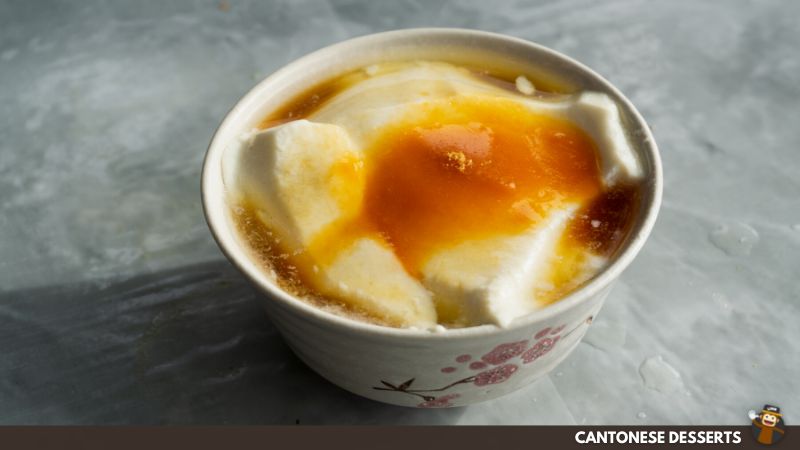
Also known as tofu pudding, Tofu fa means “tofu flower” in Cantonese, which is indeed the most classic Hong Kong dessert. It is made with silky smooth pudding, soy milk, and gypsum flour in a wooden bucket to make a velvety pudding. Since tofu isn’t naturally sweet, it is generally sweetened with ginger syrup or brown sugar.
杏仁茶 (Hang6 Jan4 Caa4) – Almond Tea

Almond tea is created with ground apricot kernels and sticky white rice. Imperial families traditionally ate it as a healthful treat that promotes beautiful skin. Sometimes it’s served with an egg white, so request without.
涼粉 (Loeng4 Fan2) – Grass jelly

You must try grass jelly if you’re craving a good summer treat. Grass jelly is made by boiling the stalks of the Platostoma palustre plant, then cooling them to a jelly-like consistency. It’s served with fruit, nata de coco, sweetened red beans, and coconut milk because it’s mild and a little bitter.
湯圓 (Tong1 Jyun4) – Glutinous Rice Balls
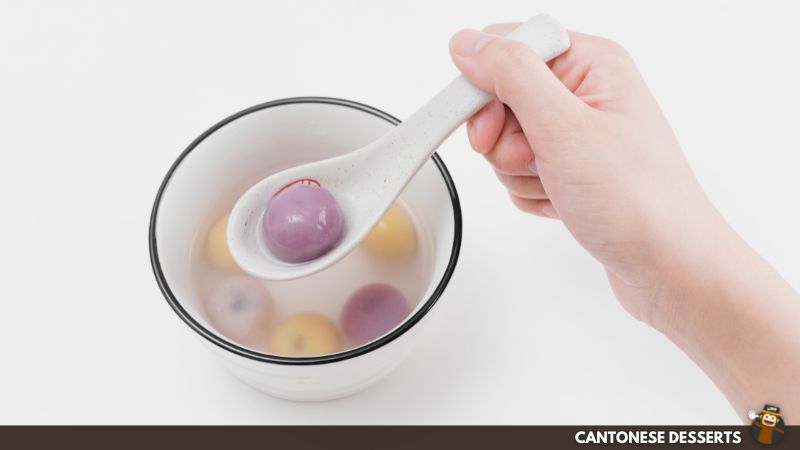
This dessert is not only one of the cutest Cantonese desserts but also one of the tastiest. These chewy dumplings come plain and in attractive colors like pastel pink and green. It is loaded with flavors like black sesame, peanut, salted egg yolk, and chocolate and is traditionally served at a family table to symbolize unity and union.
木瓜雪耳糖水 (Muk6 Gwaa1 Syut3 Ji5 Tong4 Seoi2) – Papaya Snow Fungus Sweet Soup
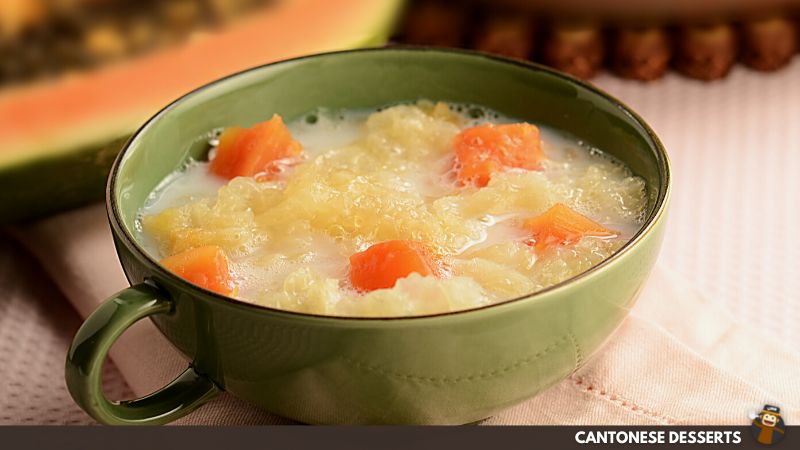
Papaya snow fungus sweet soup combines snow fungus, Chinese sweet almonds, and lily bulbs with papaya, red jujube, or longan. The result is a balanced, calming sweet soup that improves skin color and elasticity and lung and respiratory health.
番薯薑糖水 (Faan1 Syu4 Goeng1 Tong4 Seoi2) – Sweet Potato Ginger Sweet Soup
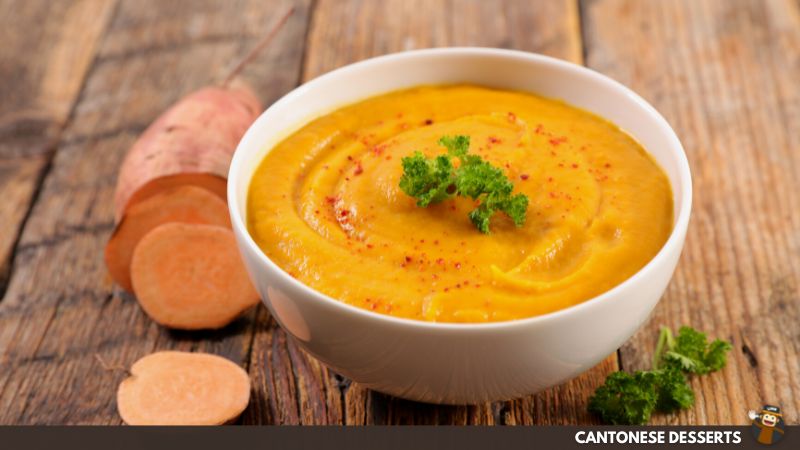
The winter months are prime time to indulge in this comforting sweet potato ginger soup. This is made of sweet potatoes and dates and flavored with sugar and ginger. It is stated that this delicacy, made with those two ingredients and occasionally with red jujube too, is healthy for the whole body, restores warmth, helps eliminate toxins, and provides a good dosage of beta-carotene.
腐竹糖水 (Fu6 Zuk1 Tong4 Seoi2) – Beancurd Skin Sweet Soup
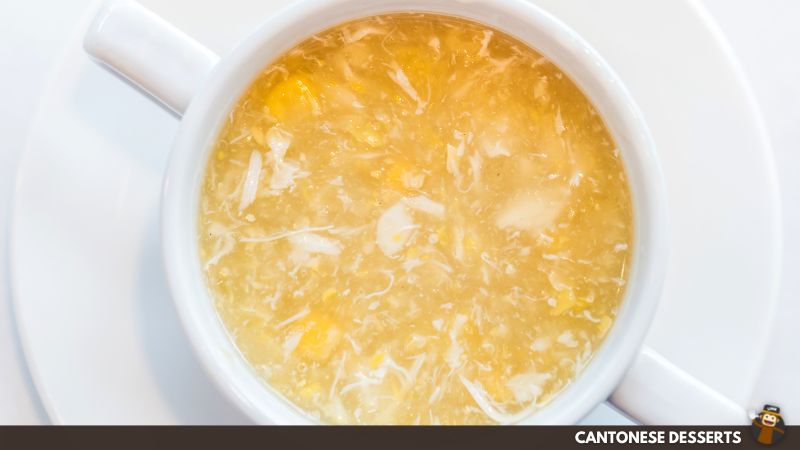
Beancurd skin sweet soup is a Cantonese tofu-based dessert. To make this dessert, you need tofu skin, ginkgo nuts, and barley cooked with rock sugar. Traditional sweet soup is often served without a boiled egg, making it vegan-friendly. Beancurd skin sweet soup is abundant in protein relieves dry throats and fights inflammation.
核桃糊 (Hat6 Tou4 Wu4) – Walnut Soup

This sweet soup is sometimes served as a “yin-yang” option with black sesame soup and is good for brain function and memory. Walnut soup’s main ingredients are water, walnuts, rice flour, and sugar make walnut soup. Sometimes coconut milk is added for extra creaminess, while red jujube and peen tongs are used to naturally sweeten the dessert. The final “paste” is quite smooth, and the soup tastes nutty.
椰汁紫米露 (Je4 Zap1 Zi2 Mai5 Lou6) – Black Glutinous Rice With Coconut Milk
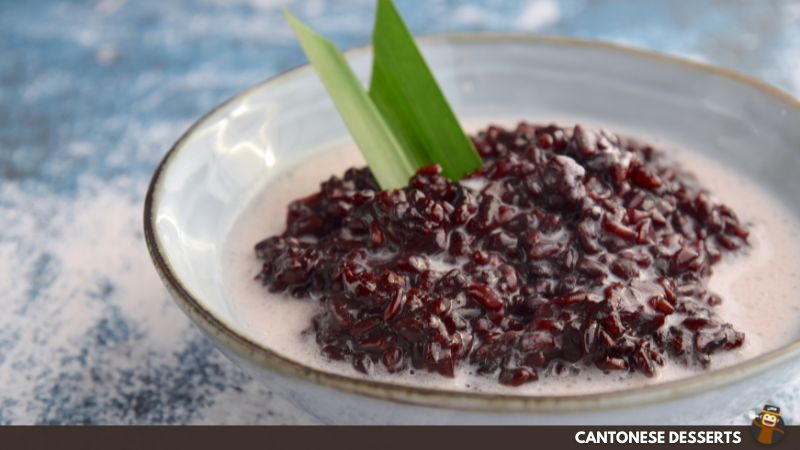
Black Glutinous rice, also known as “purple sticky rice,” is cooked and served cold. These are soft, chewy treats filled with black sesame paste, red bean paste, or peanut paste and then wrapped in glutinous rice flour. People usually eat glutinous rice balls at the Chinese New Year or Mid-Autumn Festival as a sign of love and family coming together.
Other Chinese Desserts
The Cantonese desserts mentioned above surely made your mouth water. So, here are more Chinese desserts that a person with a sweet tooth will enjoy.
Popular Dessert Spots In Hong Kong
Now that you have learned the different Cantonese desserts let us now learn where to find them. Luckily, you can easily find them in the busy cities of Hong Kong. Here are some popular dessert spots in Hong Kong, as well as their addresses and highly-recommended desserts.
1. Ming Kee Dessert
Since it first opened its doors ten years ago, the diner has garnered a strong reputation for the authentic Cantonese desserts that it serves. It is a popular gathering place for residents of the surrounding area.
Address: Ming Kee Dessert, 114 Sai Wan Ho Street, Sai Wan Ho, Hong Kong
Highly Recommended Desserts: Mango sago with glutinous rice balls and mango ice cream, Shaved ice with fresh fruits, Papaya and snow fungus sweet soup, black sesame sweet soup, glutinous rice balls with ginger soup, sweet potato soup, and grass jelly.
2. Tsui Yuen Dessert
Tsui Yuen Dessert, one of the most well-known traditional dessert stores in Hong Kong, has five locations throughout the city.
Address: Tsui Yuen Dessert, G/F, North Point Road, North Point, Hong Kong, +852 3104 1528
Highly Recommended Desserts: Steamed milk custard pudding and Glutinous balls with black sesame paste.
3. Yuen Kee Dessert
Yuen Kee Dessert is a well-known name in the area and throughout the city, and it is another traditional dessert business worthy of your attention. Guests may enjoy superb meals in a one-of-a-kind, cozy setting thanks to the restaurant’s vintage booth-style tables and chairs, glass-covered tables with menus visible underneath, and wall-mounted fans.
Address: Yuen Kee Dessert, G/F, 32 Centre Street, Sai Ying Pun, Western District, Hong Kong, +852 2548 8687
Highly Recommended Desserts: Sang Ji Sheng (lotus seed and egg) sweet soup, Chinese egg cake, and Walnut sweet soup.
4. Fook Yuen
Fook Yuen excels at making only one thing, tong yuen, to the highest possible standard. Their glutinous rice balls are stuffed to the brim with delectable filling, and they are made from scratch using only the finest ingredients.
Address: Fook Yuen, Shop I-1, G/F, Lei Do Building, 7 Fuk Yuen Street, North Point, Hong Kong, +852 3106 0129
Highly Recommended Desserts: Classic Yuen Yeung tong yuen in ginger soup, Glutinous rice balls in fermented rice wine, and Black sesame tong yuen.
5. Lung King Heen
The desserts at Lung King Heen, a three-Michelin-star restaurant, are just as impressive as the rest of the restaurant’s consistently high-quality Chinese fare.
Address: Lung King Heen, 4/F, Four Seasons Hotel Hong Kong, 8 Finance Street, Central, Hong Kong, +852 3196 8880
Highly Recommended Desserts: Red bean soup with lotus seeds and aloe vera, Crispy sesame dumplings with hazelnut and cream custard, Aand Double-boiled egg white milk custard with bird’s nest
More Dessert Spots In Hong Kong
- Tei Mou Koon Dessert
- Auntie Sweet
- Total Dessert
- Kai Kai
- Sweet Dreamer Dessert
- Yan Wo Dou Bun Chong
- Yee Shun Dairy Company
- Ching Ching
Make Your Language Learning Sweet. Learn With Ling!
Just like desserts, learning a new language like Cantonese can come in different tastes. Of course, not literally. Every language learning journey is different, so it’s nice if you have something that can help you. Luckily, Ling App can do that for you.

Ling App is a language learning platform that will help learners achieve their learning goals. With its advanced features, learners will be able to develop their language skills such as vocabulary building, speaking, listening, reading, and writing. It also offers extensive grammar instructions and blog posts to know more about their culture.
Learning Cantonese should taste sweet. So, start learning Cantonese with the Ling app now!































































